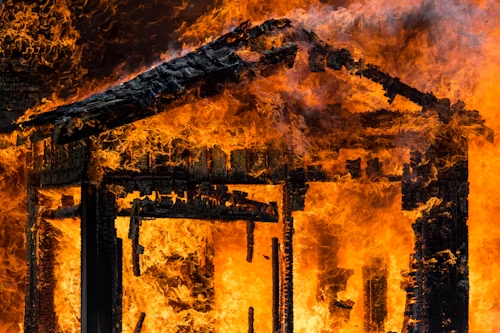After the Fire: What Business Owners Need to Do Next
A fire can be devastating for any business, damaging property, stock, equipment, and customer confidence. Once the Fire and Rescue Service (FRS) has left, the responsibility for protecting your premises and starting recovery falls to you.
Here’s a step-by-step guide for UK business owners on what to do after a fire.
1. Put Safety First
- Do not re-enter until the FRS or a building inspector confirms it’s safe.
- Fire residues, smoke particles, and firefighting water can all be hazardous.
- Staff or contractors with asthma or other health conditions should avoid the site until air quality improves.
2. Secure the Premises
- Close and lock windows and doors if safe.
- Arrange emergency boarding-up if needed (usually covered by insurance).
Inform the police if the property will be left vacant. - Remove cash, stock, or confidential files only if safe to do so.
3. Contact Your Insurer Immediately
- Notify both buildings and contents/business interruption insurers if applicable.
- Ask about:
- Alternative trading arrangements (e.g. cover for temporary premises or equipment hire).
- Business interruption insurance for loss of income.
- Request replacement copies of your policy documents if damaged.
4. Document the Damage
- Take photographs of all affected areas, including damaged stock and equipment.
- Make an inventory of losses with estimated values.
- Do not dispose of anything until your insurer or their loss adjuster confirms.
5. Utilities and Services
- Gas, electricity, and water may have been cut off. Only qualified engineers should reconnect them.
- Do not switch on damaged machinery, electrics, or IT systems until tested safe.
6. Prevent Secondary Damage
Insurers expect you to take reasonable steps to protect the property. This may include:
- Hiring a specialist fire and flood contractor to pump out water, dry the premises, and remove smoke and soot.
- Improving air quality with “air scrubbers” to protect staff.
- Protecting unaffected stock or equipment from corrosion and mould.
7. Review Your Fire Risk Assessment (FRA)
- Revisit your Fire Risk Assessment after the incident.
- Check:
- Escape routes and exit doors are still usable.
- Alarms, emergency lighting, and sprinklers work correctly.
- Fire doors, extinguishers, and signage are intact or replaced.
- Record any changes and update staff training.
8. Business Continuity and Communication
- Activate your Business Continuity Plan.
- Redirect phones and post so customers can reach you.
- Nominate a spokesperson to handle press or stakeholder enquiries.
- Reassure clients and suppliers about your ability to continue operating.
9. Work with the Loss Adjuster
- Insurers often appoint a loss adjuster to inspect and value the damage.
- Keep all correspondence, receipts, and quotes for repair or replacement.
10. Review and Plan Ahead
A fire is disruptive, it’s better to prepare in advance than wait until it’s too late.
- Many small businesses are underinsured. Review whether your sum insured still reflects the true value of your premises, stock, and equipment.
- Check your business interruption cover limits. Many businesses underestimate how long recovery can take.
- Update your fire safety measures and continuity plan.
📘 Further Resources
- London Fire Brigade – After We Leave (2024)
- South Wales Fire & Rescue Service – After the Fire (2019)
✅ Key takeaway: Act quickly, document everything, and work closely with your insurer. Business continuity planning and the right insurance cover can make the difference between survival and closure.
📞 If you’re an FSB member and need insurance support after a fire, call us on 020 3883 7976.
This content is for general information only and is not intended to provide advice or a personal recommendation. Insurance cover is subject to the terms, conditions, and exclusions of the policy. Always consider your individual circumstances and seek professional advice before arranging insurance. External websites are not under our control and we are not responsible for their content.
